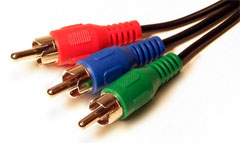YUV Video
YUV video is a type of video signal that consists of three separate signals: 1 for luminance (brightness) and two for chrominance (colours). This maintains a better quality than the traditional composite video signal used in older televisions, VHS recorders, etc.
YUV video became popular in consumer electronics with the release of DVD players. The MPEG-2 encoding system in the DVD format uses YUV, and good-quality DVD players provide YUV outputs which can be connected to a compatible television for superior quality.
Due to it's prominence in the consumer market, YUV has become synonymous with component video. However YUV is just one form of component video so the two terms should not be used interchangeably.

Connections
YUV connections require three cables (one for each part of the signal), although the cables may be combined into a single multi-core cable for convenience. The most common YUV connections use three RCA connectors colour-coded green, red and blue.
Technical Specs
YUV is a scaled version of Y B'-Y R'-Y, which is derived from gamma-corrected RGB in this formula:
Y = 0.299R' + 0.587G' + 0.114B'
The B'-Y and R'-Y values are then scaled to generate the correct U and V values.
In YUV video, the Y component is 1V with a 0.3V sync and blanking pedestal. The U and V components have a peak-to-peak amplitude of 0.7V.